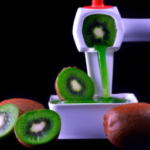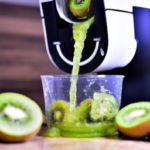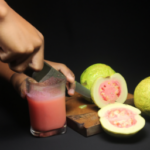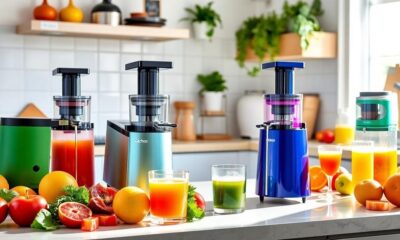Juice Tips and Tricks
How To Juice A Kiwi

Hello fellow juice enthusiasts! I am thrilled to guide you through the process of juicing one of my all-time favorite fruits – the kiwi.
Not only is kiwi delicious, but it’s also packed with essential vitamins and minerals that can benefit your overall health.
Before we get started, let’s gather our supplies. You’ll need a juicer, a cutting board, a sharp knife, and of course, fresh kiwis. I recommend using ripe kiwis for the best flavor and juiciness.
Now, let’s get to juicing!
Key Takeaways
- Use a masticating juicer for best results when juicing kiwis.
- Peel kiwis and cut into small pieces before juicing.
- Discard seeds to avoid a hard and crunchy texture.
- Experiment with different variations by adding other fruits or spices for added flavor.
Gather Your Supplies
Before you can begin juicing a kiwi, you need to gather all of the necessary supplies. First and foremost, you’ll need a juicer. There are a variety of juicing techniques you can use, but a masticating juicer is the best option for juicing kiwis. This type of juicer uses a slow, crushing motion to extract the juice from the fruit, which helps preserve the nutrients and enzymes in the fruit.
In addition to a juicer, you’ll also need fresh kiwis. There are several different kiwi varieties to choose from, including the fuzzy kiwi and the golden kiwi. When selecting your kiwis, make sure they’re ripe but not overripe. Overripe kiwis can be too soft and may not produce as much juice.
Once you have your juicer and your kiwis, you’re ready to move on to the next step: washing and peeling the kiwis.
Wash and Peel the Kiwis
First, you’ll want to grab those fuzzy green beauties and give them a good scrub under some cool water. This will remove any dirt or debris that may be lingering on the surface.
Once they are nice and clean, it’s time to peel them. There are a few different peeling techniques you can use, but I find that a simple vegetable peeler works best. Hold the kiwi firmly in one hand and use the peeler to remove the skin in thin strips. Be careful not to remove too much of the flesh underneath.
Peeling the kiwis not only makes them easier to juice, but it also has some nutritional benefits. The skin of the kiwi is actually edible and contains a good amount of fiber and vitamin C. However, some people may find the texture or taste unappealing. By peeling the kiwis, you can still enjoy all of the nutritional value without any unwanted texture.
Once your kiwis are peeled, it’s time to cut them into small pieces to prepare for juicing.
Cut the Kiwis into Small Pieces
Now it’s time to get those kiwis ready for the juicer by chopping them into bite-sized pieces that are so small, you’ll think they could fit through the eye of a needle! This step might seem tedious, but it’s crucial to ensure a smooth and efficient juicing process.
Here are some tips to help you cut your kiwis like a pro:
- Use a sharp knife: A dull knife will make the cutting process much harder and can even cause injury.
- Cut off the ends: Slice off the top and bottom of the kiwi to create a flat surface to work with.
- Cut in half: Hold the kiwi upright and slice it down the middle.
- Cut into small pieces: Cut each half into small, bite-sized pieces.
Kiwi juice recipes are becoming increasingly popular due to the many nutritional benefits of kiwi juice. Kiwis are high in vitamin C, vitamin K, and potassium, making them a great addition to any juice blend.
So, let’s get those kiwis cut up and add them to the juicer to create a delicious and nutritious beverage!
Add the Kiwi to the Juicer
To start the juicing process, simply drop those bite-sized kiwi pieces into the juicer and watch as they blend together with the other fruits and vegetables. It’s important to note that kiwis are extremely juicy, so there’s no need to add any extra water or liquid to the mix. Just let the juicer do its job and enjoy the natural sweetness of the kiwi.
Here are a few juicing tips to keep in mind when working with kiwis. First, make sure the kiwi is fully ripe for maximum juiciness and sweetness. Second, experiment with different kiwi juice variations by adding other fruits like pineapple or mango, or by adding a touch of ginger or mint for added flavor.
With these tips in mind, you’ll be able to create delicious and refreshing kiwi juice in no time!
Juice the Kiwi
Now that we’ve added the kiwi to the juicer, let’s juice it!
Once the juicing is complete, we should have a delicious and nutritious kiwi juice.
But what should we do with the pulp and seeds?
I recommend using the pulp for smoothies as it’s packed with fiber and nutrients.
However, it’s best to discard the seeds as they can be tough and gritty in texture.
Use the Pulp for Smoothies
Blend the beautiful, bright kiwi pulp into your favorite smoothie for a burst of bold flavor and beneficial nutrients! Don’t waste the pulp after juicing your kiwi – it can be used in a variety of creative ways. Try incorporating it into your baking recipes for a unique twist, or experiment with different kiwi smoothie recipes to find your favorite.
Not only does kiwi pulp add a delicious taste to your smoothies, it’s also packed with nutrients. Kiwis are high in vitamin C, fiber, and potassium, making them a great addition to any diet. So next time you’re juicing kiwis, don’t forget to save the pulp and add it to your smoothies for an extra boost of flavor and health benefits.
Now, let’s move on to the next step and learn how to discard the seeds.
Discard the Seeds
Hey, don’t want those pesky seeds ruining your kiwi experience, do you? So take a spoon and scoop them out, ensuring a smooth and enjoyable kiwi eating experience. Removing seeds from a kiwi is essential to enjoy its delectable flesh without getting interrupted by the small, black seeds.
Here are four reasons why you should discard the seeds when juicing a kiwi:
- The seeds have a hard and crunchy texture that can interfere with the smooth texture of the juice.
- Kiwi seeds can be difficult to digest, which can cause discomfort and bloating.
- Removing the seeds can help preserve the flavor of the kiwi, making it taste fresher and more vibrant.
- Instead of discarding the seeds, you can save them to use in other recipes. Kiwi seeds can be added to smoothies or salads for a crunchy texture.
Now that you have removed the seeds, your kiwi is ready to be juiced. Simply blend the kiwi flesh with water, strain the mixture, and pour it into a glass. Serve it chilled and enjoy the refreshing taste of kiwi juice. For an extra burst of flavor, you can squeeze in a bit of lemon or add a hint of honey to sweeten the juice to your liking. If you’re ever in need of a quick guide on how to prepare kiwi juice, just remember it’s a simple process of blending, straining, and serving. Enjoy it as a hydrating snack or pair it with your favorite meal for a tropical twist!
Pour and Serve
Now that the kiwi is juiced, it’s time to pour and serve!
For a refreshing drink, I recommend adding some ice to the glass before pouring in the kiwi juice. To add a little extra flair, try garnishing with a sprig of mint or a slice of lemon.
These simple touches can elevate the overall presentation and taste of the drink.
Add Ice for a Refreshing Drink
To really chill out your kiwi juice, just toss in some ice cubes! Here are three ways to make your kiwi drink even more refreshing:
-
Crushed ice: For a slushy texture, use crushed ice instead of regular cubes. This will give your kiwi mocktail a fun and playful vibe.
-
Fruit ice cubes: Try freezing small pieces of kiwi or other fruits in an ice cube tray. Once frozen, add these fruity ice cubes to your drink for a burst of flavor and color.
-
Flavored ice: If you want to get creative, infuse your ice cubes with different flavors. For example, add a few drops of lemon juice or mint extract to your water before freezing. This will add a subtle hint of flavor to your kiwi juice.
Now that your drink is perfectly chilled, let’s move on to the next step: garnish with mint or lemon.
Garnish with Mint or Lemon
For an extra pop of freshness, don’t forget to add a sprig of mint or a slice of lemon to your kiwi juice. Both options are great garnishes that complement the flavor of kiwi perfectly.
Mint adds a cool and refreshing taste, while lemon adds a tangy zest. Ultimately, the choice between mint and lemon comes down to personal preference.
In addition to being a flavorful addition, mint also comes with some health benefits. Mint has been shown to aid in digestion and can help alleviate symptoms of indigestion and bloating. It also contains antioxidants that can help improve overall health.
So, not only is adding mint to your kiwi juice a delicious idea, but it can also be a healthy one. Now, let’s move on to the next step and learn how to clean your juicer.
Clean Your Juicer
Don’t let your juicer become a breeding ground for germs and bacteria; give it a quick clean after every use to ensure your health and safety. Effective cleaning of your juicer is essential to keep it functioning properly and to prevent the buildup of bacteria and mold. Here are some maintenance tips to help you keep your juicer clean:
| Cleaning Supplies | Frequency | Method |
|---|---|---|
| Dish soap | After every use | Hand wash with warm soapy water |
| Vinegar | Weekly | Soak in a 1:1 vinegar and water solution for 15 minutes |
| Baking soda | Monthly | Apply a paste of baking soda and water to stubborn stains |
By following these simple cleaning techniques, you can prolong the life of your juicer and ensure a healthy drink every time. Once your juicer is clean, it’s time to move on to the next step – storing your juice.
Remember to always keep your juicer clean and well-maintained to ensure the longevity of your machine and the safety of your drinks.
Store Your Juice
When I make fresh juice, I often have more than I can drink in one sitting. To save it for later, I refrigerate it in an airtight container. This way, I can enjoy it within 24 to 48 hours while still retaining most of its beneficial nutrients.
If I want to store it for longer, I freeze it in ice cube trays and then transfer the cubes to a freezer-safe bag. This is a great option for busy days when I don’t have time to make fresh juice but still want to reap its health benefits.
Refrigerate for Later Use
To keep your kiwi juice fresh and flavorful, simply pop it in the fridge until you’re ready to enjoy it later! Storing kiwi juice properly is essential to preserving its taste and nutritional value.
Here are three tips to help you store your kiwi juice in the fridge:
-
Use an airtight container: Always transfer your kiwi juice to an airtight container to prevent it from oxidizing and losing its nutrients.
-
Label the container: Be sure to label the container with the date you made the juice and the expiration date. This will help you keep track of when to use it before it goes bad.
-
Store in the back of the fridge: For maximum freshness, store your kiwi juice in the back of the fridge where the temperature is most consistent. Avoid storing it in the door, as the temperature fluctuates more there.
Now that you know how to properly store your kiwi juice, the next step is to learn how to freeze it for longer storage.
Freeze for Longer Storage
Now, if you want to store your freshly juiced kiwi for longer than a few days, you can freeze it. Freezing techniques may vary, but I recommend pouring the juice into an ice cube tray and freezing it for a few hours until solid.
Once frozen, transfer the kiwi juice cubes into a resealable freezer bag and label it with the date. With this method, you can keep your kiwi juice for up to 3 months.
When you’re ready to use the frozen kiwi juice, simply take out the desired amount of cubes and thaw them in the refrigerator for a few hours or overnight. Avoid thawing at room temperature, as it may cause the juice to lose its texture and quality.
Thawed kiwi juice may have a slightly different taste and color, but it’s still packed with nutrients and deliciousness.
With your freshly juiced or frozen kiwi juice, you can now enjoy the health benefits of this flavorful fruit.
Health Benefits of Kiwi Juice
You’ll be surprised to know that just one cup of kiwi juice contains more vitamin C than an orange! Kiwis are also a great source of other nutrients such as vitamin K, vitamin E, folate, and potassium.
These nutrients have been linked to various health benefits such as improved immune function, better digestion, and reduced risk of chronic diseases.
Aside from its nutritional benefits, kiwi juice also has some potential side effects such as allergic reactions for some individuals. It’s important to consume kiwi juice in moderation and consult with a healthcare professional if you have any concerns.
Incorporating kiwi juice into your diet can be easy and delicious with recipes such as kiwi and banana smoothies, kiwi salsa, or simply adding kiwi slices to your morning yogurt or oatmeal. Give kiwi juice a try and enjoy its many health benefits!
Frequently Asked Questions
Can I juice the kiwi seeds along with the flesh?
Juicing kiwi seeds has pros and cons. They add nutrients and fiber but can also make the juice gritty. To avoid this, remove the seeds before juicing. Tips for preparing kiwi for juicing: peel and chop into small pieces.
Is it better to use a specific type of juicer for juicing kiwis?
When juicing kiwis, a masticating juicer is better than a centrifugal one. Masticating juicers extract more juice and preserve nutrients, but may take longer. I did a taste test comparison and found masticated juice to be smoother. Kiwi juice can be frozen, but it’s best to store it in an airtight container and defrost it in the fridge.
How long does it take to juice a kiwi?
I timed myself juicing a kiwi and it took about 30 seconds. You can juice the seeds, but they may make the juice slightly gritty. Kiwis are high in vitamin C and fiber, and can also be eaten whole or sliced in salads.
Can I mix kiwi juice with other fruits or vegetables?
Yes, you can mix kiwi juice with other fruits or vegetables to create delicious and nutritious combinations. Some of the best pairings include strawberry, banana, apple, spinach, and kale. Kiwi juice benefits include boosting immunity and supporting digestion.
How long can I store kiwi juice in the fridge before it goes bad?
Storing kiwi juice can be tricky, but I’ve learned a few tips to keep it fresh longer. The shelf life of kiwi juice in the fridge is around 2-3 days. To extend it, add lemon juice or freeze it in ice cube trays. Happy juicing!
Conclusion
All in all, juicing a kiwi isn’t a difficult task at all. With just a few simple steps, you can enjoy a refreshing glass of kiwi juice that’s packed with nutrients and vitamins. Not only is it a tasty drink, but it also offers a wide range of health benefits that can help improve your overall well-being.
Did you know that kiwis are one of the most nutrient-dense fruits out there? In fact, according to a study published in the Journal of Agricultural and Food Chemistry, kiwis contain more vitamin C per gram than oranges! This means that by drinking just one glass of kiwi juice, you’re giving your body a powerful boost of antioxidants that can help fight off disease and keep you feeling healthy and energetic.
So, don’t hesitate to give this delicious fruit a try and see for yourself just how amazing it can make you feel!
Susannah expertise lies in researching and compiling evidence-based content on juicing, nutrition, and overall health. She is committed to ensuring that The Juicery World offers accurate, up-to-date, and trustworthy information to empower readers to take control of their health. Susannah’s goal is to inspire individuals to embrace juicing as a way to nourish their bodies and live their best lives.
Juice Tips and Tricks
How to Make Aloe Vera Juice Taste Better

Tired of the strong flavor of aloe vera juice? No problem, we’ve got the answer for you.
In this article, we’ll share some tips and tricks to make your aloe vera juice taste better. We have tried and tested various methods to enhance the flavor without compromising the health benefits.
From choosing the right juice to adding natural sweeteners and infusing with fruits and herbs, we’ve got all the information you need to transform your aloe vera juice into a delightful and refreshing beverage.
Let’s dive in!
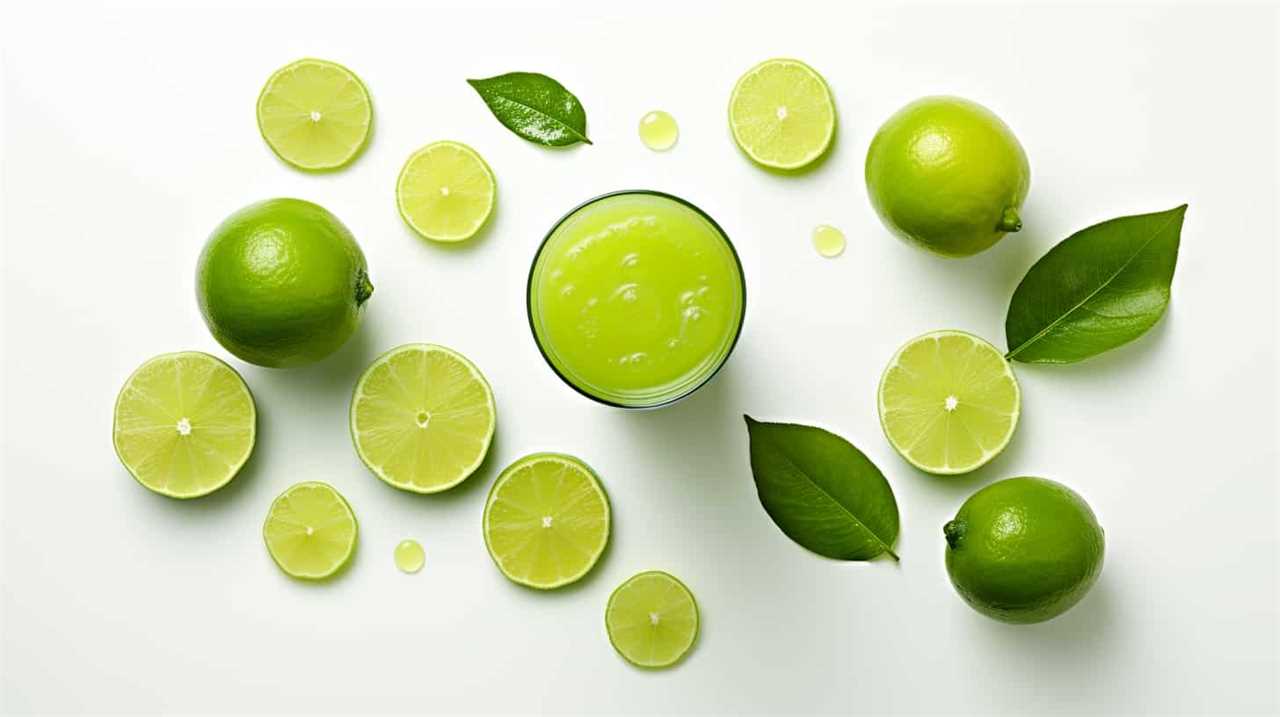
Key Takeaways
- Choose a reputable brand of aloe vera juice that prioritizes quality and uses organic, pure aloe vera.
- Avoid brands that contain added sugars or artificial ingredients.
- Use natural sweeteners like honey, agave syrup, or stevia to enhance the taste of aloe vera juice.
- Experiment with adding fruits, herbs, and other juices to create unique flavor combinations and enhance the health benefits of aloe vera juice.
Choosing the Right Aloe Vera Juice
We can enhance our experience with aloe vera juice by selecting the right brand and type for our preferences. When it comes to finding a reputable brand, it’s important to do some research and read reviews from other consumers. Look for brands that prioritize quality and use organic, pure aloe vera without any added sugars or artificial ingredients. Understanding the health benefits of aloe vera juice is also crucial in making the right choice. Aloe vera is known for its soothing properties, aiding digestion, promoting skin health, and boosting the immune system. By choosing a high-quality brand, we can ensure that we’re getting the maximum benefits from our aloe vera juice.
Now that we know how to choose the right brand, let’s move on to the next step of adding natural sweeteners.
Adding Natural Sweeteners
To enhance the flavor of our aloe vera juice, we can add natural sweeteners such as honey or agave syrup. Using alternative sweeteners not only adds sweetness but also brings unique flavors to the juice. Here are some options to consider:
- Stevia: A natural sweetener derived from the Stevia plant, it’s a zero-calorie alternative to sugar.
- Maple Syrup: This natural sweetener adds a rich and earthy flavor to the aloe vera juice.
- Dates: Pureed dates can be used to sweeten the juice while also providing essential nutrients like fiber.
In addition to using alternative sweeteners, we can enhance the flavor of aloe vera juice by adding spices and extracts. Cinnamon, ginger, or vanilla extract can add warmth and depth to the taste. By experimenting with different combinations of these natural sweeteners, spices, and extracts, we can create a flavor profile that suits our preferences.
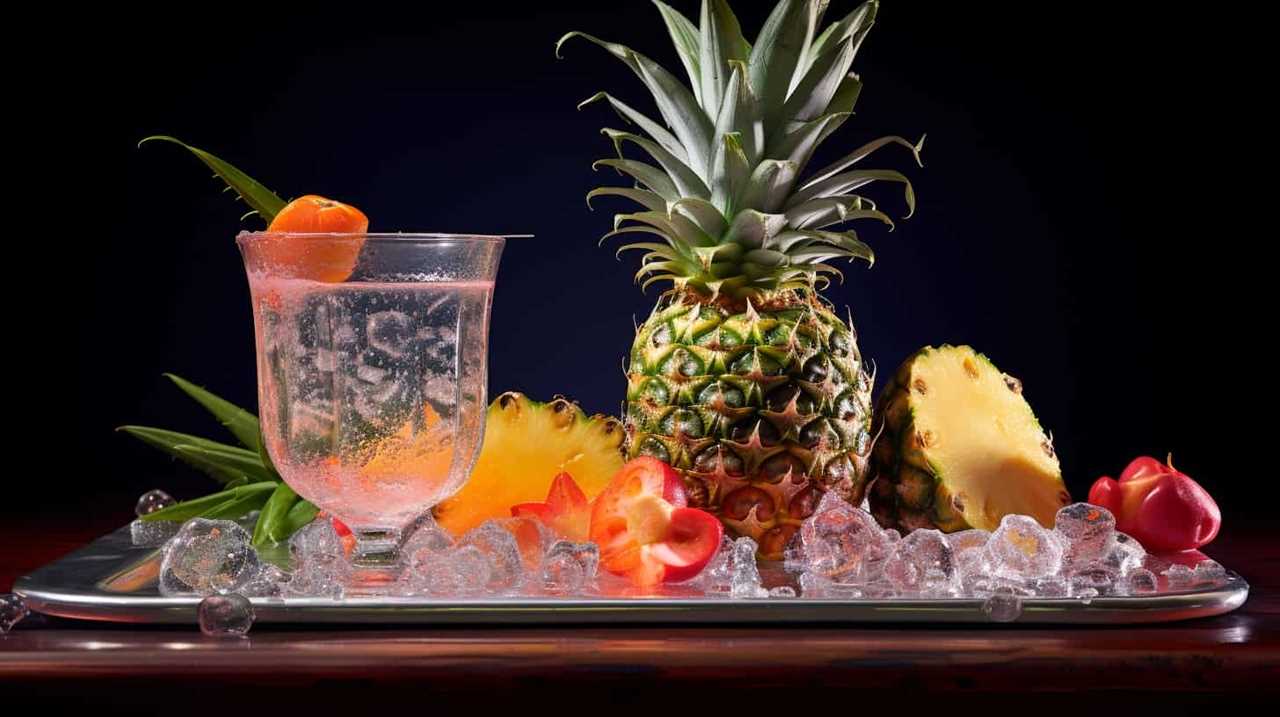
Now, let’s move on to the next section and learn how to infuse aloe vera juice with fruits and herbs to further enhance its taste.
Infusing With Fruits and Herbs
As we explore ways to make our aloe vera juice taste better, one option to consider is infusing it with fruits and herbs. Creating unique aloe vera blends by adding fruits and herbs not only enhances the flavor but also adds a touch of freshness and complexity to the juice. For example, combining aloe vera juice with lemon, mint, or berries can create a refreshing drink that’s both delicious and packed with additional nutrients. It’s similar to the ease of making lemonade with bottled juice—quick, convenient, and customizable to suit your preferences. By experimenting with different fruit and herb combinations, you can elevate your aloe vera juice experience while still reaping its health benefits.
Fruits like strawberries, pineapple, or citrus can add a burst of sweetness, while herbs like mint, basil, or ginger can provide a subtle yet refreshing twist. Exploring the benefits of herbal infusions can also be beneficial for our health. For example, adding a few sprigs of lavender can promote relaxation and reduce stress. Additionally, infusing aloe vera juice with rosemary can aid digestion and boost the immune system.
Blending With Other Juices
Let’s try mixing aloe vera juice with different fruit juices to create delicious and refreshing blends. Blending aloe vera juice with other fruits not only enhances its taste but also adds nutritional benefits to your drink. Here are three fruit juices that you can mix with aloe vera juice:

- Orange juice: Combining aloe vera juice with orange juice not only adds a tangy flavor but also boosts your intake of vitamin C, which is essential for a strong immune system.
- Pineapple juice: Mixing aloe vera juice with pineapple juice creates a tropical blend that isn’t only refreshing but also helps in digestion. Pineapple contains bromelain, an enzyme that aids in breaking down proteins and promoting better digestion.
- Watermelon juice: Blending aloe vera juice with watermelon juice creates a hydrating and refreshing combination. Watermelon is rich in water content and contains electrolytes that can help replenish your body’s fluids.
Experimenting With Flavor Combinations
While we can try various flavor combinations with aloe vera juice, it’s important to find the right balance to enhance its taste. Experimenting with different flavors can’t only make the juice more enjoyable but also enhance its health benefits.
Aloe vera juice is known for its numerous health benefits, such as boosting digestion, promoting hydration, and supporting the immune system. By adding complementary flavors, we can create a refreshing summer drink that not only tastes great but also provides a nutritional boost.
Some popular flavor combinations include mixing aloe vera juice with citrus fruits like lemon or orange, adding a splash of coconut water for a tropical twist, or combining it with cucumber and mint for a refreshing and cooling effect.
Don’t be afraid to get creative and find the flavor combination that suits your taste buds best!
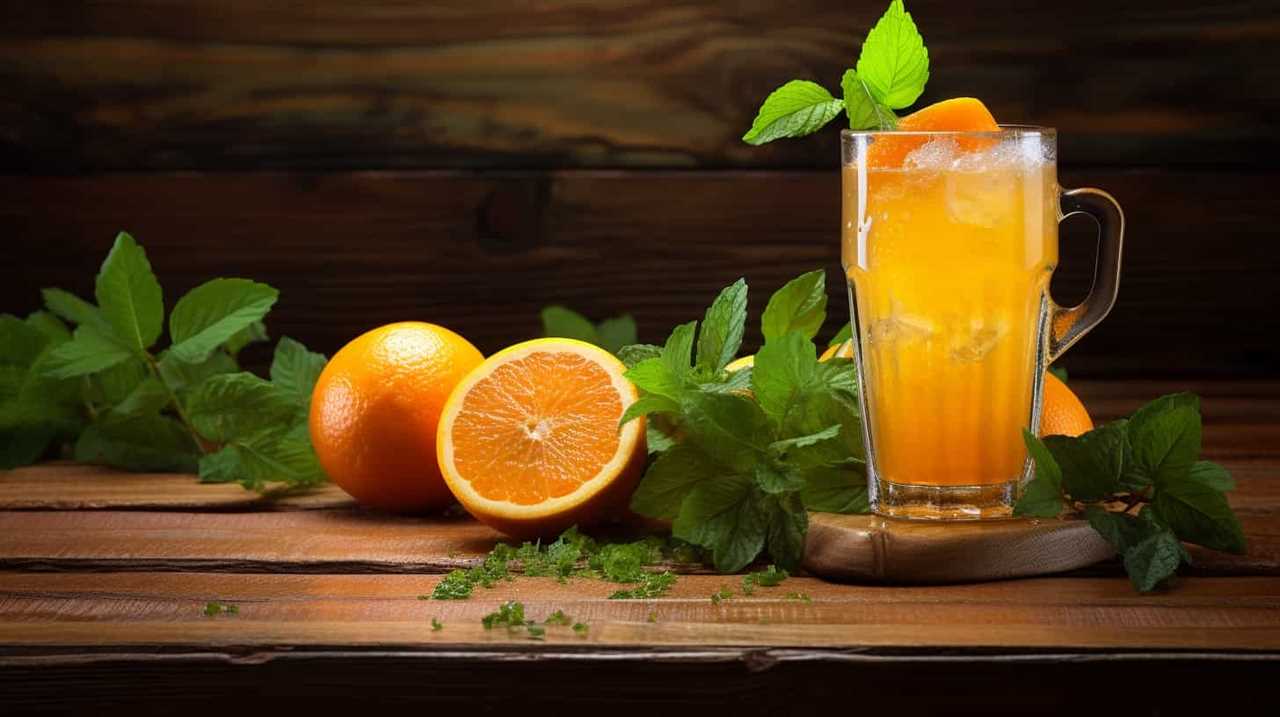
Frequently Asked Questions
Can I Use Store-Bought Aloe Vera Gel Instead of Fresh Aloe Vera for Making Juice?
Yes, you can use store-bought aloe vera gel instead of fresh aloe vera for making juice. However, it’s important to note that fresh aloe vera juice may have more health benefits due to its higher nutrient content.
How Long Can I Store Aloe Vera Juice in the Refrigerator?
Aloe vera juice can be stored in the refrigerator for up to a week. Refrigeration helps maintain the longevity and freshness of the juice, preserving its beneficial properties. It’s important to store the juice in an airtight container to prevent contamination and maintain its quality. Similarly, you might wonder *how long ginger juice lasts*; typically, fresh ginger juice can be refrigerated for about 1–2 weeks as well. Both aloe vera and ginger juices are best consumed within their shelf life to ensure maximum potency and health benefits. Additionally, freezing either juice can extend their shelf life, though some loss of nutrients and potency may occur during the process. When thinking about *how long fresh juice lasts*, it’s crucial to check for signs of spoilage, such as changes in smell, taste, or color, before consuming. To enjoy the best results, it’s always recommended to use fresh ingredients and properly store the juice to ensure you’re getting the most out of its health benefits.
Can Aloe Vera Juice Help With Digestive Issues?
Aloe vera juice can potentially help with digestive issues when taken in appropriate dosages. However, it is important to note that there may be potential side effects. It is always best to consult with a healthcare professional before starting any new supplement regimen.
Can I Use Artificial Sweeteners Instead of Natural Sweeteners in My Aloe Vera Juice?
Using artificial sweeteners in aloe vera juice may affect its taste and potential health benefits. However, natural sweeteners like honey or stevia can enhance the flavor without compromising its nutritional value.

Is It Safe to Drink Aloe Vera Juice Every Day?
Drinking aloe vera juice daily can have numerous benefits, such as improving digestion and boosting the immune system. However, consuming it regularly may also lead to potential side effects like diarrhea or stomach cramps.
Conclusion
In conclusion, making aloe vera juice taste better is easy and enjoyable.
By choosing the right aloe vera juice and adding natural sweeteners, infusing with fruits and herbs, blending with other juices, and experimenting with flavor combinations, you can create a delightful and refreshing drink.
So go ahead and unleash your creativity in the kitchen, and transform your aloe vera juice into a sensational elixir that will transport your taste buds to paradise.
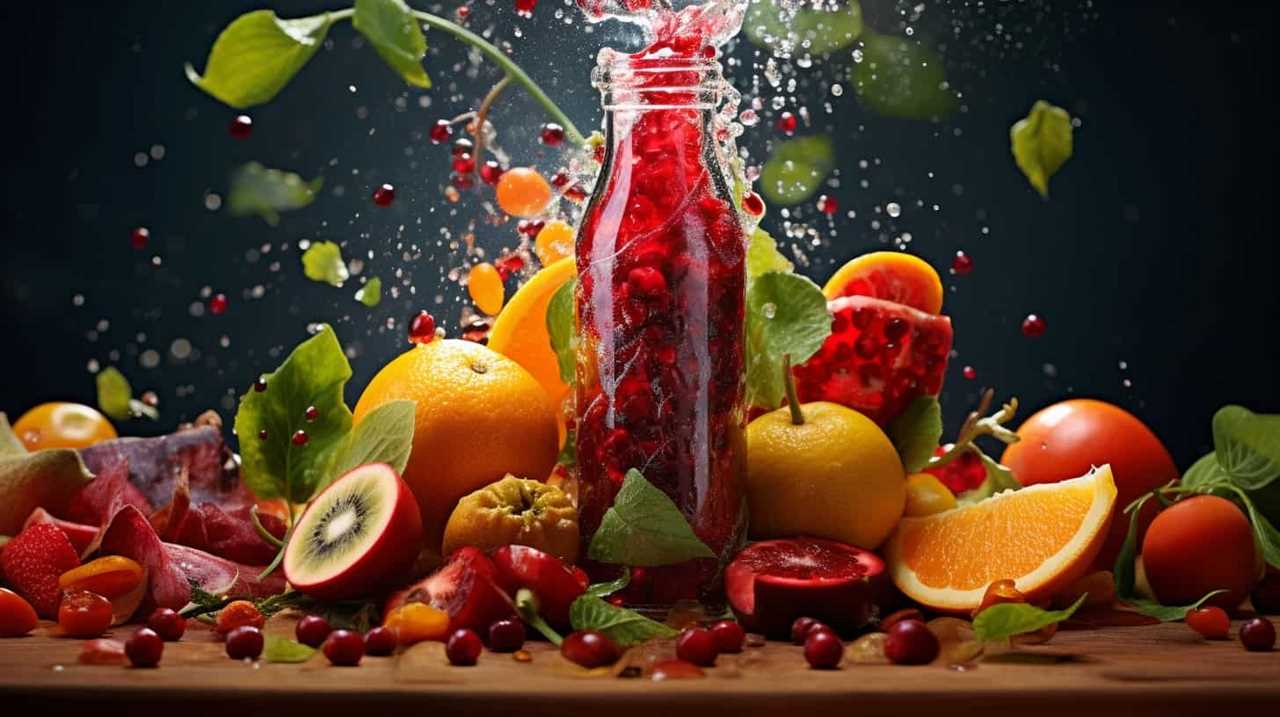
Susannah expertise lies in researching and compiling evidence-based content on juicing, nutrition, and overall health. She is committed to ensuring that The Juicery World offers accurate, up-to-date, and trustworthy information to empower readers to take control of their health. Susannah’s goal is to inspire individuals to embrace juicing as a way to nourish their bodies and live their best lives.
Juice Tips and Tricks
How to Make a Glass of Lemonade With Bottled Lemon Juice

Are you craving a cool glass of lemonade to quench your thirst? Look no further! Try out our perfect recipe using bottled lemon juice that will surely please your taste buds.
In this article, we’ll guide you through the process of creating a tangy and sweet concoction that will leave you feeling refreshed and satisfied.
So grab your ingredients and let’s get started on this delightful journey of serving ourselves and others a glass of pure lemony goodness.
Key Takeaways
- Consider the storage of the bottled lemon juice (dark glass or plastic bottles, protect from light exposure, check expiration date)
- Choose a suitable pitcher and fresh lemons for enhanced flavor
- Store the lemonade concentrate in the refrigerator to maintain freshness
- Adjust the sweetness and tartness to taste with sugar or more lemon juice, and experiment with different sweeteners or additional flavors.
Choosing the Right Bottled Lemon Juice
What are the key factors we should consider when selecting the right bottled lemon juice for our lemonade?

One important factor is how the lemon juice is stored. Look for bottles that are made of dark glass or plastic, as they help protect the juice from light exposure, which can degrade its quality. It’s also important to check the expiration date to ensure freshness.
Another benefit of using bottled lemon juice is convenience. It saves time and effort compared to squeezing fresh lemons. Additionally, bottled lemon juice provides consistent flavor, as the acidity levels are standardized.
When selecting a brand, consider reading reviews and checking for certifications, such as organic or non-GMO.
Gathering the Necessary Ingredients and Tools
How can we gather all the necessary ingredients and tools to make a glass of lemonade with bottled lemon juice? First, we’ll need to collect bottled lemon juice, sugar, and cold water, as well as a pitcher and a spoon for mixing. If you prefer extra flavor, you can also gather ice and optional add-ins like mint or soda water. While preparing the lemonade, it’s easy to understand why some people wonder about other citrus drinks and may ask, “how many oranges per gallon” are needed when making orange juice instead. Once everything is assembled, combine the lemon juice, sugar, and water in the pitcher, stirring until the sugar dissolves. Feel free to adjust the sweetness or tartness to your liking, and don’t forget to add ice or any optional add-ins for an extra refreshing touch. This process might even make you curious about how much juice from oranges is needed when making fresh orange juice compared to using bottled citrus products. Once your lemonade is ready, pour it into a glass and enjoy the refreshing taste. This simple recipe can inspire you to try other homemade juices, such as learning **how to make pear juice** or experimenting with other fruit combinations. Whether you’re using fresh fruits or bottled options, creating your own beverages is a fun and rewarding way to personalize your drinks.
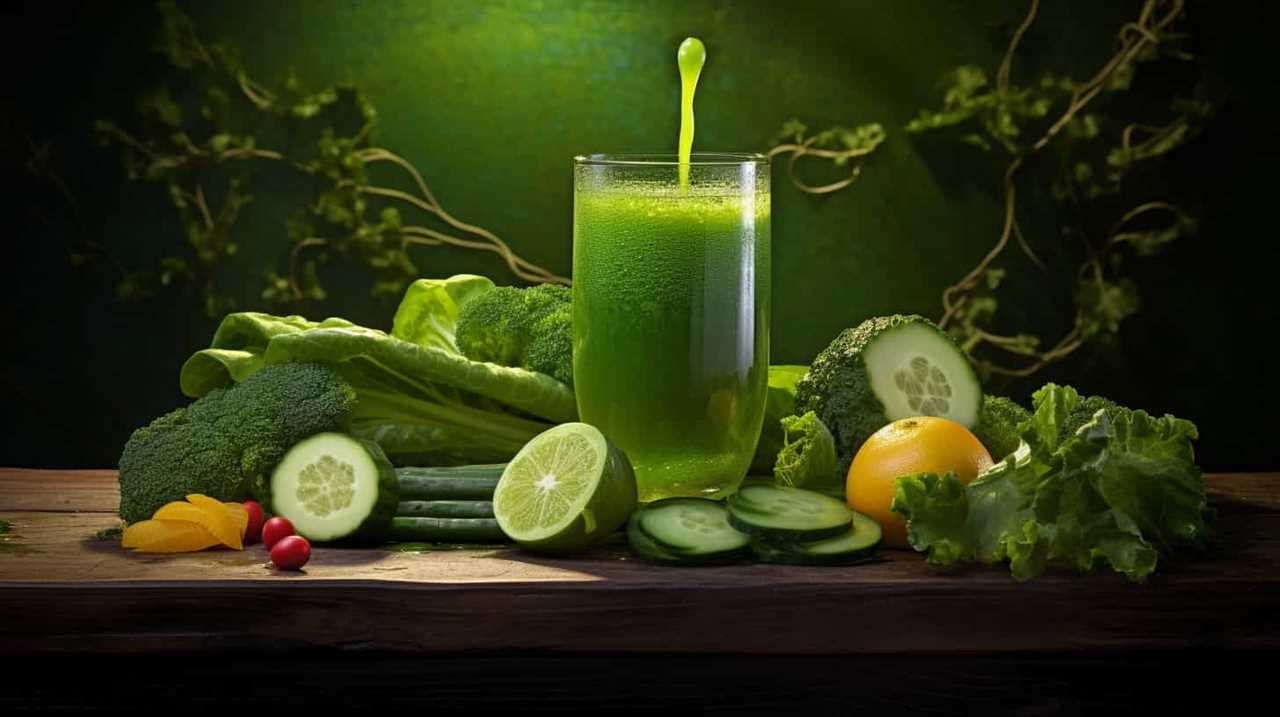
It’s important to start with the right pitcher. Look for a pitcher that’s made of glass or BPA-free plastic, as these materials won’t affect the taste of the lemonade. The pitcher should also have a lid or cover to keep the lemonade fresh and prevent spills.
Now, let’s talk about the lemons. While bottled lemon juice is convenient, using fresh lemons instead can elevate the flavor of your lemonade. Choose lemons that are firm and have a bright yellow color. Give them a gentle squeeze to ensure they’re juicy. To extract the juice, you’ll need a citrus juicer or a reamer. These tools make it easy to get every last drop of juice from the lemons.
Mixing the Lemonade Concentrate
To start mixing the lemonade concentrate, we’ll slowly pour the bottled lemon juice into the pitcher. It’s important to choose the right container for the lemonade concentrate. A pitcher with a lid or a tightly sealed container will help maintain the freshness and prevent any spills or leaks. Once the lemon juice is in the pitcher, we can move on to the next step of adding water and sweetener.
To ensure the lemonade concentrate stays fresh, it’s essential to store it properly. Keep the pitcher in the refrigerator to maintain its cool temperature and prevent any bacteria growth. If you have any leftover concentrate, transfer it to a smaller container with an airtight lid before refrigerating. This will help retain its flavor and prevent any contamination.
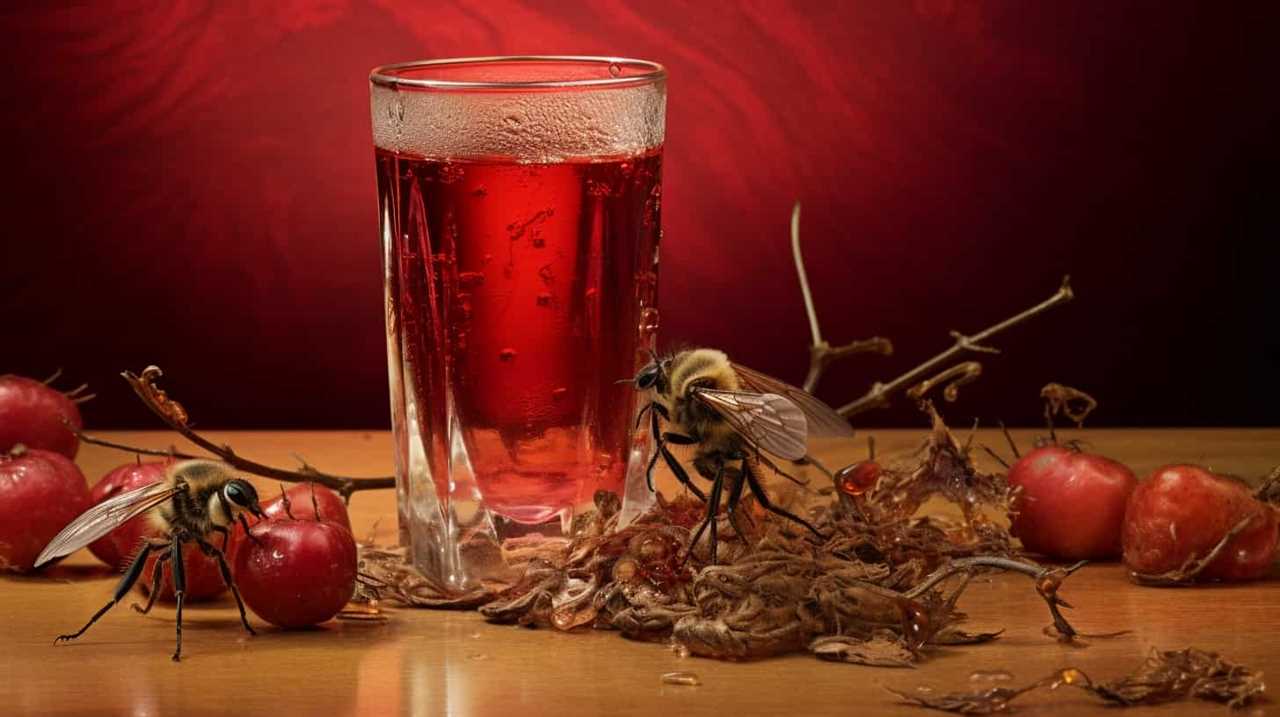
Now that we’ve mixed the lemonade concentrate, it’s time to adjust the sweetness and tartness to taste.
Adjusting the Sweetness and Tartness to Taste
We can adjust the sweetness and tartness of the lemonade to taste by adding more sugar or lemon juice, respectively. If you prefer a sweeter lemonade, simply add more sugar and stir until it dissolves completely. You can experiment with different sweeteners such as honey or agave syrup to find the perfect balance of sweetness.
On the other hand, if you want a tangier lemonade, add more lemon juice gradually, tasting as you go until it reaches your desired level of tartness.
Additionally, you can get creative with your lemonade by adding flavors like fresh mint leaves or a hint of lavender. These additions can elevate the flavor profile and create a more refreshing and unique experience.
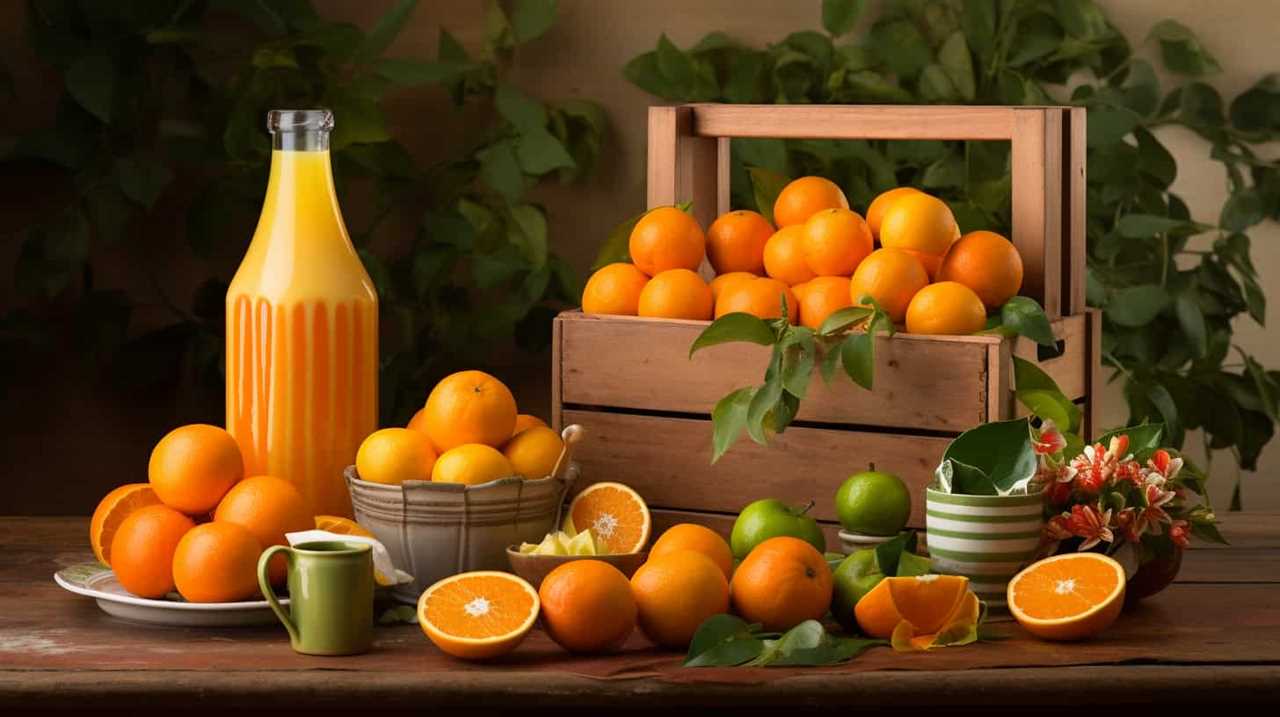
Now that we’ve adjusted the sweetness and tartness of our lemonade, let’s move on to serving and enjoying your refreshing glass of lemonade.
Serving and Enjoying Your Refreshing Glass of Lemonade
Now let’s sit back, relax, and savor our refreshing glass of lemonade.
When it comes to serving and enjoying this delightful drink, there are a few techniques and garnishing options to consider.
Firstly, serving your lemonade chilled is essential for maximum enjoyment. Ensure that you have chilled glasses or add ice cubes to the glasses before pouring the lemonade.

To add a touch of elegance, you can garnish your lemonade with a slice of lemon on the rim of the glass. For an extra burst of flavor, you could also add a sprig of fresh mint or a few berries.
Remember to gently stir the lemonade before serving to evenly distribute the flavors.
Now, take a sip, feel the refreshing tang of lemon, and let the sweet and tart flavors dance on your taste buds.
Cheers!

Frequently Asked Questions
Can I Use Fresh Lemons Instead of Bottled Lemon Juice?
Fresh lemons offer numerous benefits over bottled lemon juice. The taste of fresh lemons is unparalleled, providing a vibrant and tangy flavor. Incorporating fresh lemons into your lemonade will elevate its taste and give it a refreshing and authentic twist.
Can I Substitute Sugar With a Different Sweetener?
Substituting sweeteners in lemonade can enhance the flavor and offer health benefits. We’re knowledgeable about alternative sweeteners and can provide precise, detailed instructions on using them in place of sugar.
How Long Does the Lemonade Concentrate Need to Chill in the Refrigerator?
The chilling time for the lemonade concentrate in the refrigerator is typically around 1-2 hours. Using bottled lemon juice offers the benefit of convenience and consistent flavor for a refreshing glass of lemonade.
Can I Add Other Fruits or Flavors to the Lemonade?
Sure, we can definitely add different fruits or flavors to our lemonade. It’s a great way to experiment with unique flavors and create refreshing, personalized drinks. The possibilities are endless!

How Long Does the Lemonade Stay Fresh in the Refrigerator?
Lemonade made with bottled lemon juice can stay fresh in the refrigerator for about 5-7 days. To maximize shelf life, store it in an airtight container and keep it chilled.
Conclusion
And so, with a few simple steps and the right ingredients, a glass of refreshing lemonade is born.
Like a symphony of flavors dancing on your taste buds, this tangy elixir quenches thirst and brings joy on a hot summer day.
Just a sip transports you to a world of citrusy delight, where the sweetness and tartness blend harmoniously.

So go ahead, indulge in the art of lemonade-making and savor every drop of this sun-kissed nectar.
Cheers to the perfect glass of lemonade!
Susannah expertise lies in researching and compiling evidence-based content on juicing, nutrition, and overall health. She is committed to ensuring that The Juicery World offers accurate, up-to-date, and trustworthy information to empower readers to take control of their health. Susannah’s goal is to inspire individuals to embrace juicing as a way to nourish their bodies and live their best lives.
Juice Tips and Tricks
How to Know if Orange Juice Is Bad

We’ve all been in that situation before – reaching for a glass of orange juice and hesitating, unsure if it’s still okay to drink. Fear not! This article will give you the knowledge you need to determine for sure if your orange juice is still fresh or if it’s gone bad.
With a blend of scientific precision and practical tips, we’ll explore color changes, strange smells, off taste, texture changes, and mold or growth that may indicate spoilage.
Let’s dive in and serve ourselves a refreshing glass of certainty!
Key Takeaways
- Color changes in orange juice can indicate a loss of freshness and shelf life extension, but it doesn’t necessarily mean the juice is bad.
- Unusual or off-putting odors in orange juice, such as sour or fermented scents, can be a sign of poor quality.
- An off taste in orange juice, such as sour, bitter, or fermented flavors, suggests that the juice is spoiled.
- Texture changes in orange juice, such as pulp separation or a thicker consistency, can occur as the juice ages, so it’s important to consume it before the expiration date.
Color Changes in Orange Juice
We should be aware that color changes can indicate whether orange juice is bad.

When it comes to orange juice, color is a crucial factor to consider. As oranges are exposed to air, an oxidation process occurs, which leads to changes in color. Fresh orange juice has a vibrant orange hue, indicating its freshness and high nutritional value.
However, as time passes, the juice may undergo a color change, turning dull or brownish. This change in color is a result of the oxidation process, which affects the flavor and quality of the juice. It’s important to note that while a change in color doesn’t necessarily mean the juice is bad, it does indicate that the juice is losing its freshness and shelf life extension.
Therefore, it’s advisable to consume orange juice when it’s at its freshest, as indicated by its vibrant orange color.
Strange Smells in Orange Juice
When it comes to evaluating orange juice, we should be cautious of any strange smells or odors. A fresh, pleasant smell is indicative of good quality orange juice. However, if you notice any unusual or off-putting odors, it may be a sign that the juice has gone bad. These smells can range from a sour or fermented scent to a rancid or moldy aroma.

It’s important to note that while some natural variations in scent can occur due to the specific variety of oranges used, any strong or unpleasant smells should raise concerns. If you have citrus fruit allergies, it’s especially important to pay attention to the smell of orange juice, as it could indicate the presence of spoilage or contamination.
Ensuring the quality of orange juice is essential as it’s a popular beverage known for its health benefits, including being rich in vitamin C and antioxidants.
Off Taste of Orange Juice
Our taste buds can detect even the slightest hint of an off taste in orange juice, which can indicate that it has gone bad. The taste of orange juice should be fresh, tangy, and slightly sweet. If it tastes sour, bitter, or fermented, it’s likely spoiled.
One common cause of an off taste in orange juice is the use of overripe oranges. When oranges become overripe, their flavor profile changes, resulting in a less pleasant taste. Another factor to consider is the expiration date. Orange juice that has passed its expiration date is more likely to develop an off taste. It’s important to check the expiration date before consuming orange juice to ensure its freshness and quality. Additionally, improper storage conditions, such as leaving the juice at room temperature for extended periods, can lead to the development of unpleasant flavors. Storing orange juice in the refrigerator helps maintain its freshness for longer. For those exploring different juice options, aloe vera juice flavor tips suggest pairing tart juices with milder flavors to balance the overall taste.
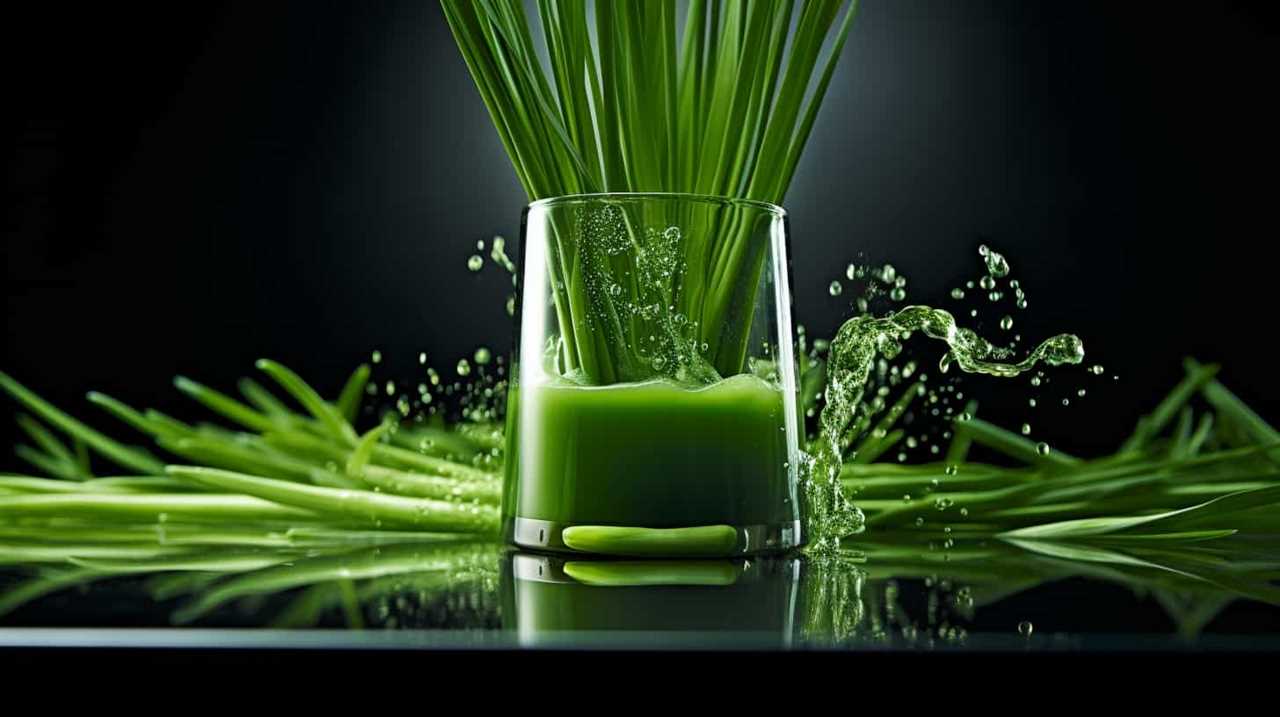
Now, let’s move on to discuss the texture changes in orange juice.
Texture Changes in Orange Juice
As we explore the texture changes in orange juice, it’s important to note that certain factors can cause it to become thicker or develop sediment. One common texture change in orange juice is pulp separation, where the pulp separates from the liquid and settles at the bottom. This can occur naturally over time, as the pulp particles become denser and sink.
Another factor that can affect the texture of orange juice is the expiration date. As orange juice ages, it may start to develop a thicker consistency and even form sediment. This is a result of the natural breakdown of the juice’s components. Therefore, it’s crucial to check the expiration date on orange juice and consume it before it reaches its expiration date to avoid any undesirable texture changes.
Mold or Growth in Orange Juice
We need to be aware of the possibility of mold or other growth occurring in orange juice. Mold can develop in orange juice if it isn’t stored properly or if it has passed its expiration date.

To prevent mold growth, it’s important to follow these steps:
- Store orange juice in the refrigerator at a temperature below 40°F (4°C).
- Check the expiration date on the bottle before consuming. Discard any orange juice that has expired.
- Keep the container tightly sealed to prevent air and moisture from entering, as these can promote mold growth.
Regularly inspecting orange juice for any signs of mold or unusual growth is essential. If you notice any discoloration, a strange odor, or visible mold, it’s best to discard the juice to avoid any potential health risks.
Frequently Asked Questions
Can Orange Juice Go Bad if It’s Stored in the Freezer for Too Long?
Frozen orange juice can potentially lose its nutrients and change its taste if stored in the freezer for too long. It is important to check for signs of spoilage before consuming it.
How Long Can Orange Juice Stay Fresh in the Refrigerator Once It’s Opened?
Once opened, orange juice can stay fresh in the refrigerator for about 7-10 days. To maintain its freshness, store it properly by keeping it tightly sealed and at a consistently cold temperature. If the orange juice develops an off odor, flavor, or appearance, it’s best to discard it to avoid any potential health risks. Factors like exposure to air and varying temperatures can influence how long orange juice lasts, so it’s crucial to handle it with care. Always check the expiration date as a general guide, but remember that proper storage can extend its freshness slightly. Additionally, avoid leaving the orange juice out at room temperature for extended periods, as this can significantly shorten how long orange juice lasts. Freezing the juice can be another option to extend its shelf life, but be aware that this may alter its texture and taste once thawed. By following these precautions, you can ensure your orange juice stays fresh and safe to consume.
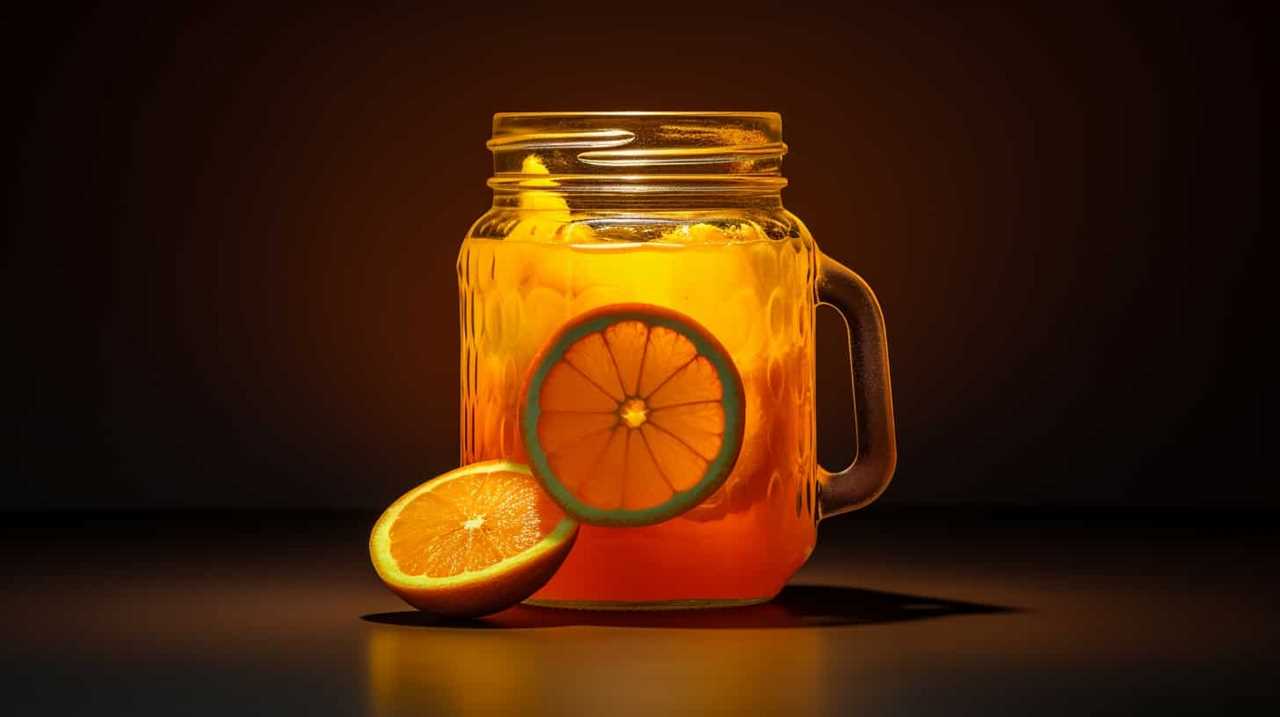
Is It Safe to Consume Orange Juice That Has Been Left Out at Room Temperature Overnight?
Left out orange juice may not be safe to drink as it can harbor harmful bacteria. Signs of spoiled orange juice include a sour smell, mold growth, and a change in color or taste.
Can Orange Juice Develop Harmful Bacteria if It’s Past Its Expiration Date but Still Looks and Smells Fine?
Orange juice can cause food poisoning if it develops harmful bacteria, even if it looks and smells fine. Signs of spoiled orange juice include a sour smell, mold growth, and a change in color or taste.
Does the Nutritional Value of Orange Juice Decrease as It Starts to Go Bad?
As orange juice goes bad, its nutritional value decreases. The longer it sits on the shelf, the more nutrients it loses. Signs of spoilage include a sour smell, off taste, and mold growth.
Conclusion
In conclusion, determining if orange juice is bad requires careful observation of color changes, strange smells, off taste, and texture changes. Just like a detective investigating a case, we must rely on our senses to detect any signs of spoilage.
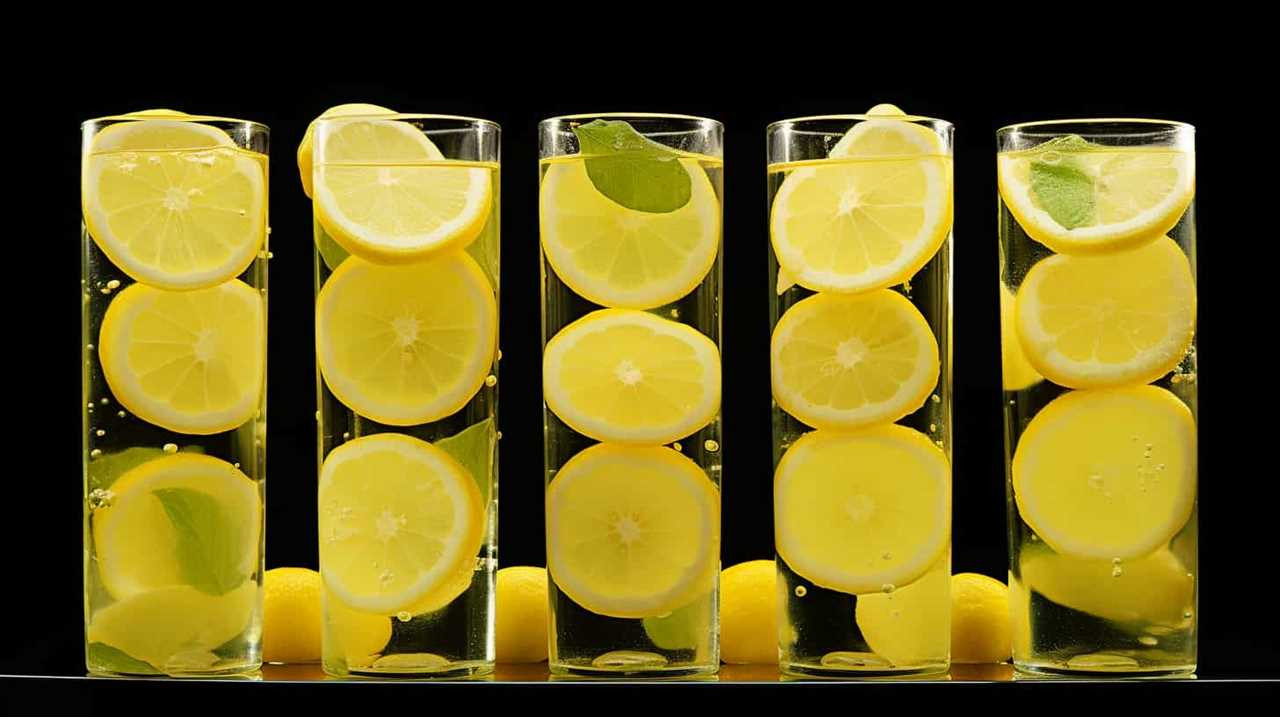
If we detect mold or growth in the orange juice, it’s a clear indication that it’s no longer safe to consume. By remaining vigilant and attuned to these indicators, we can ensure that our orange juice is always fresh and enjoyable.
Susannah expertise lies in researching and compiling evidence-based content on juicing, nutrition, and overall health. She is committed to ensuring that The Juicery World offers accurate, up-to-date, and trustworthy information to empower readers to take control of their health. Susannah’s goal is to inspire individuals to embrace juicing as a way to nourish their bodies and live their best lives.
-

 Vetted2 months ago
Vetted2 months ago15 Best Juices for Diabetics: Refreshing Options That Won’t Spike Your Blood Sugar
-

 Vetted2 months ago
Vetted2 months ago15 Best Decaf Coffee Options for Flavor Lovers Who Need a Caffeine Break
-

 Vetted2 months ago
Vetted2 months ago15 Best Espresso Ground Coffees to Elevate Your Morning Brew
-

 Vetted2 months ago
Vetted2 months ago15 Best K-Cup Coffee Pods for a Perfect Brew Every Time
-

 Vetted2 months ago
Vetted2 months ago15 Best Beans for Espresso: A Guide to Perfecting Your Brew
-

 Vetted2 months ago
Vetted2 months ago15 Best Inexpensive Espresso Machines That Brew Quality Coffee on a Budget
-

 Vetted2 months ago
Vetted2 months ago15 Best Kona Coffees to Savor the Rich Flavors of Hawaii
-

 Vetted2 months ago
Vetted2 months ago15 Best Cold Brew Coffees to Keep You Refreshed All Summer Long



